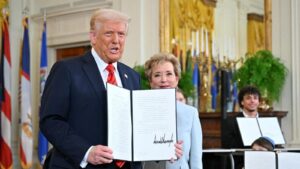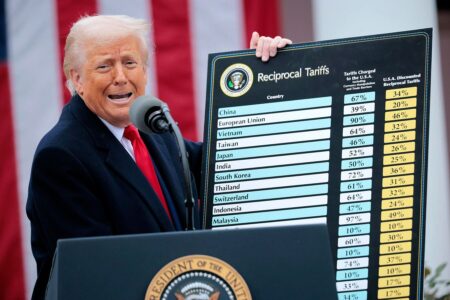The Department of Education announced on Monday that major collections efforts against millions of defaulted federal student loan borrowers will be resuming in a matter of weeks. These efforts will include involuntary collections activities that allow the government to intercept tax refunds, offset Social Security payments, and garnish wages from employment, all without a court order.
The announcement comes as student loan borrowers are facing unprecedented pressures. The repayment system is mired in turmoil, student loan forgiveness is blocked or threatened across several programs, and the department faces severe personnel reductions following mass firings and resignations. Millions of borrowers are already in default, with many more starting to fall behind on their monthly payments – just as economic conditions begin to worsen.
Observers across the student loan space – from advocacy groups to loan servicers – are warning that the current environment could be catastrophic for borrowers in the coming months. Starting in March 2020, many borrowers who were delinquent or in default on their student loans did not have any repayment obligations due to Covid-19 relief measures. And Biden-era relief programs designed to ease the transition back to normal repayment subsequently protected borrowers from the worst impacts of student loan delinquency and default. But those programs ended last year. And with today’s announcement, the Trump administration has made clear that the federal student loan collections machine is about to turn back on.
“Borrowers have fewer resources than ever to navigate their repayment options, and those options are ever shifting,” said The Institute for College Access and Success, or TICAS, in a blog post earlier this month warning of a “looming disaster” for borrowers. “For many borrowers, this is likely to mean default. For those already in default, getting back on track is likely to be even more difficult than ever.”
Student Loan Repayment Remains In Turmoil While Loan Forgiveness Is Blocked For Several Programs
For much of the last six months, millions of student loan borrowers have been unable to access income-driven repayment plans. IDR programs are long-term repayment options that offer borrowers affordable monthly payments based on their income and family size. Borrowers who haven’t paid off their balance in full can receive student loan forgiveness after 20 or 25 years in repayment under IDR plans.
But the IDR system has been mired in unprecedented chaos since last summer, when a federal court issued an injunction blocking the SAVE plan, a Biden-era IDR program that offered lower monthly payments and faster student loan forgiveness than the older IDR options (the ICR, IBR, and PAYE plans). More than eight million borrowers have been forced into a forbearance as a result. And student loan forgiveness has now been blocked not only under SAVE, but also under ICR and PAYE, which were created via the same legal process. These disruptions have also impacted borrowers who are pursuing student loan forgiveness through Public Service Loan Forgiveness, a program that can eliminate a borrower’s federal student loan debt in as little as 10 years if they commit to working at certain nonprofit or government employers.
Then, in February, after a broader ruling was issued in the SAVE plan litigation, the Department of Education shut down the entire IDR system, preventing borrowers from applying for these programs and halting all application processing. The American Federation of Teachers filed a lawsuit in March arguing that the Trump administration’s actions were unlawful and not required by the recent court ruling. In response, the Department of Education restored access to the IDR application and indicated that processing is expected to resume in May. However, hundreds of thousands of borrowers remain stuck in limbo due to a large and growing application backlog.
“We have people who have been waiting for 6 months” or longer after submitting their IDR application, said attorneys for the AFT at a court hearing last week. “We have more than a million people in a backlog” that is only growing larger as the processing pause continues for now.
A department official indicated on Monday that 1.8 million IDR applications are in the queue to be processed. Attorneys for the AFT and the Department of Education are expected to file a report later this week if they can reach an agreement on information-sharing as officials work to restore access to IDR plans.
Student Loan Delinquencies Rising As Borrowers Fall Behind On Payments
Between the chaos associated with the current IDR system and the fact that millions of Americans may not have had to make payments on their student loans for years due to Covid-era flexibilities, many borrowers are starting to fall behind as bills pile up.
According to The New York Times, around four million student loan borrowers are currently delinquent on their loans, resulting in negative credit reporting that can interfere with purchasing a home, buying a car, or renting an apartment. At least nine million borrowers may become delinquent on their student loans by this summer, suggested the Federal Reserve Bank of New York.
“Dysfunction in the federal government continues to keep federal student loan borrowers in a state of perpetual chaos,” said TICAS in its blog post. “While the pandemic payment pause provided critical relief for many borrowers, the transition back into repayment had been a bumpy, confusing one, even before the added tumult of the current administration.”
Millions At Risk Of Student Loan Collections, Including Wage Garnishment And Treasury Offset
Following today’s announcement, borrowers who are severely delinquent or in default on their federal student loans may have very little time to avert severe financial consequences. Federal student loan default typically occurs after a borrower has been behind on payments for 270 days (the equivalent of approximately nine months).
According to a Department of Education official on Monday, four million borrowers are in late-stage delinquency on their federal student loans. At least 10 million borrowers could end up in default in just a matter of months. And TICAS estimates that 6.8 million borrowers are currently in default, a number roughly echoed by the department official.
“In addition to ongoing credit score damage and hefty collection fees, the federal government also wields vast extra-judicial powers to collect student debt, including garnishing wages and seizing Social Security payments and tax refunds that are targeted to households with very low incomes, including the Child Tax Credit and the Earned Income Tax Credit,” said TICAS. “These seizures compound financial hardship for those who can least afford it.”
According to the official, the department will restart the Treasury Offset program – which allows the government to intercept or offset federal tax refunds, Social Security payments, and other federal income streams – by May 5th. And the department will also restart administrative wage garnishment, which allows the government to seize a portion of a borrower’s employment income without a court order – after a 30-day notice period. Under both collections programs, borrowers are supposed to receive an initial notice and an opportunity to respond before Treasury Offset or administrative wage garnishment can begin.
Defaulting on federal student loans can lead to a host of significant secondary consequences, as well.
“The federal government, states, and colleges can also impose a series of harsh penalties that are unrelated to collecting payments, including restricting access to further federal aid, withholding a student’s academic transcripts, and suspending professional and even driver’s licenses,” said TICAS. “These measures are not only punitive, they’re also self-defeating: by undermining someone’s ability to cover basic expenses, return to school to finish a degree, keep their job, or even drive a car, the default system makes it harder for someone who is already struggling to secure their financial footing.”
Borrowers can sometimes access programs to cure federal student loan default and restore their loans back to good standing again. But with the recent significant cuts to Department of Education staff, TICAS warns that accessing these programs might become more difficult just when people need them the most. And as millions of additional borrowers are expected to fall behind on student loan payments in the coming months, with many of them potentially going into default after 270 days of delinquency, the situation may become dire.
“Without immediate intervention, we could face the largest wave of defaults in the program’s history,” one major student loan servicer told The New York Times this week. The Department of Education appeared to concur, with one official on Monday saying there is a record number of federal student loan borrowers at risk of delinquency and default in the current environment.
Read the full article here











